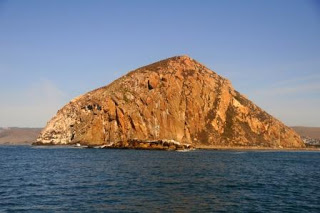 Leaving Morro Bay.
Leaving Morro Bay.
Log Book
- Port of departure: Morro Bay, CA
- Departure time: 11:15am on Monday, November 19
- Port of arrival: Santa Barbara, CA
- Arrival time: 1:15pm on Tuesday, November 20
- Total travel time: ~26 hours
- Nautical miles travelled: ~109
- Engine hours start – end – logged: 815 – 833 – 18
- Gallons of diesel start – end – used: 30 – 23.2 – 6.8
- Weather: On Monday the forecast called for variable winds 10
knots or less, becoming W 10 knots in the afternoon and NW 5-15 knots in the
evening. NW swell 5-8 feet at 12 seconds with wind waves 2 feet or less. On
Tuesday the forecast called for NW winds 5-15 knots, becoming 10-20 knots with
local gusts to 25 after rounding Point Conception.
There was a fairly narrow weather window to get
around Point Conception between patterns of strong wind, followed by the big
seas that wind tends to kick up. There was a small craft advisory in effect for
big seas through from Sunday afternoon to Monday morning. We left late on Monday morning. It was a 2 day weather window that promised relatively mild wind and seas.
We started the day with baked goods from a local bakery and
though the pastries themselves weren’t noteworthy, the sugar high I got from my
Danish was. I would just like to take this opportunity to say that what we call
a Danish in the US should be considered blasphemy to the people of Denmark,
whose pastries I would gladly shave a couple years off of my life for. Even so,
I’ll settle for our version when I need a fix. Many warn about eating heavy,
sugary, buttery things before taking to the seas, but my sweet tooth constantly
aches for pastries and we hadn’t satisfied the craving over the weekend (opting
instead for a more traditional, greasy spoon affair).
Jeff and I were feeling good after a weekend of catching up
on all sorts of things like showers, laundry, sleep, pumping out our poop tank,
movies, dancing, etc. We were not, however, looking forward to an all-nighter
without our beloved doctor (aka our autopilot), who was on “sabbatical” somewhere in New Hampshire.
The doc was going to meet up with us in LA though, so we needed to get a move
on. This experience without an autopilot makes me both appreciate the doctor
(when (s)he is fully functional) and greatly admire our friends who transited
the Pacific coast without one (hats off to you).
A quick note on the significance of this passage. Just like
any Point or Cape along the coast (Cape Disappointment, Cape Perpetua, Cape
Mendocino, etc), the weather and waves can be unpredictable and are oftentimes
a bit more boisterous where the land juts out into the water. Not sure exactly
how this phenomena works, but everyone warns you about the next point, and each
point we pass is cause for celebration and relief. Point Conception is the
“turn in the road” where the coast cuts away to the east. Once you pass Point
Conception the winds are warmer, the seas are calmer and it offers you greater
protection from the winter storms that slam the Northern Pacific Coast.
Anyway, back to the trip. The swells just outside of the
Morro Bay jetties were big but gentle, with very long periods. The winds were
indeed variable for most of the afternoon and were less than 10 knots (more in
the 3-4 knot territory). When we felt the wind coming out of the SE we were
concerned that we might have a repeat of our last attempt around Point Conception, but by 2:30pm it was blowing from the W/NW (phew), which means we
wouldn’t be going upwind.
By about 4pm the wind picked up to 10 knots and we raised
the sails. We sailed with a full jib and a full main for 1.5 hours until it
started to get dark. We reefed the main just in case the 25 knot gusts that
NOAA predicted decided to make an appearance. The wind tapered down and after
creeping along at a sluggish pace (our nephew could probably crawl faster), we
turned the motor on and motor sailed.
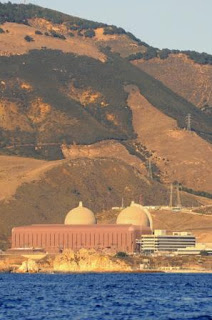 Hee hee. What we believe to be a power plant.
Hee hee. What we believe to be a power plant.
Since we were hand steering this whole passage we decided to
take 2 hour shifts, with a 15-30 minute “transition time” between shifts to
change sails or do other things that require more than one set of hands or eyes.
On a whole, the evening was rather uneventful. We had no wind coming around
Point Conception (nothing, nada, no gusts to 25) and the waves were very
manageable (much less than the 6-8 feet that were predicted).
At 1:30am the engine became possessed and started reducing
the RPMs (without us laying a finger it). We got the hint and let her rest. We
bobbed along at about 1 knot for an hour until that West wind we were promised
started picking up speed. By 3am we were sailing along at a pretty good clip.
We were able to sail with a steady W/NW wind until 9am, when it died down again
and switched to an E/SE wind. We motored the rest of the way to Santa Barbara.
When we were rounding Point Arguello (before Conception) we
thought we saw a cruise ship (lit up like a city), but it didn’t seem to be
moving very quickly…or at all. As we got closer we realized it was an oil
platform. There are a series of them marching down the coast between the
Channel Islands and the mainland. I passed one in the morning as the sun was
rising and noticed that it had a boat standing at attention near the platform,
watching us intently. It changed its location around the platform as we inched
closer, like a guard dog around its owner’s ankles. A speaker crackled and
blared, but I couldn’t make out the words. In my delirium I was convinced this
voice was speaking to me and was telling me to switch to Channel 53 on my
radio…but my radio didn’t have a Channel 53. The guard dog retreated when it
became apparent that we weren’t a threat.
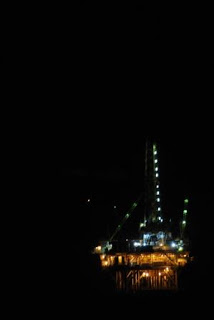 Not a cruise ship.
Not a cruise ship.  Oil rig at sunrise in the Santa Barbara channel.
Oil rig at sunrise in the Santa Barbara channel.
The only other thing of note was the pervasive smell of hot tar as we rounded the point. It’s a smell I associate with a
congested desert city, like LA, not with the wide open ocean. When you’re
sitting alone on the ocean at 1:00am looking at oil platforms and smell burning oil, you start to imagine all the things that might be happening on those rigs in the middle of the night – it would be interesting to
tour one. For an interesting history of offshore oil production in the Santa Barbara channel click here.
At one point Jeff thought it was our engine emitting those fumes,
turns out it wasn’t. About 5 miles from our turn into Santa Barbara, I also noticed a thin film of oil coating the surface of the water. It continued this way
for 2 miles. When I mentioned this to Jeff
he told me he had seen something similar during his last watch. It turns out that there are natural seeps of crude oil and gas:
According to the National
Research Council of the U.S. National Academy of Sciences, natural oil seeps are
responsible for the largest amount of oil in the marine environment, nearly 50
percent. The National Oceanic and Atmospheric Administration estimates that 2,000 to 3,000 gallons of crude oil is
released daily from the seeps off Coal Oil Point near UC Santa Barbara.
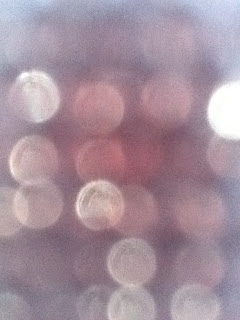 This was my attempt at using my iPad to take a photo of the oil sheen…doesn’t really do the job, but it’s kinda pretty.
This was my attempt at using my iPad to take a photo of the oil sheen…doesn’t really do the job, but it’s kinda pretty.
We arrived in Santa Barbara right on schedule, anchored up
about 300 feet East of Stearns Wharf (as recommended by Charlie’s charts) and decided that we were going to treat
ourselves to a post Point Conception drink. A sign nailed to the side of the
wharf where we tied up our dinghy informed us that anchoring and mooring were
not allowed within 1 mile of the wharf (yikes). We decided to temporarily
ignore the sign in search of some cold beer and munchies.
As we climbed the
wood ladder to the top of the wharf I saw a chubby hand fly out over the railing, pointing at the water. A little boy above us, unaware of our
presence, exclaimed “Woah, look at that boat! That big red boat!”
“Woah, yeah. cool boat! Look at all the boats out there!!!” Another little boy replied, pointing his hand to the boats that had followed the rules and
were a mile away from the wharf. These small, sweet little faces peered over
the side and noticed us climbing up. “Hi,” they said in unison.
“Hi there.”
“Where are you going?” One boy asked.
“Oh, we’re just coming in from our boat.”
“That boat?!?!” The other boy exclaimed, pointing to our red
boat.
“Yup, that’s our boat!”
They looked at each other with awe in their eyes and for a
moment I felt the allure of celebrity. That earned us a lot of cred with these
two little boys and it was just about the best welcome to shore after a long
trip.
When we finished a filling, delicious and expensive lunch in town we returned to
the boat, fired up the engine and prepared to lift the anchor when we noticed
the Harbor Patrol zooming towards us, probably eagerly awaiting our return to
the boat. We told them we had seen the sign and we were preparing to move.
Supposedly it’s a seasonal requirement (from October 1 to April 1). During the
summer months you can anchor close to the wharf (within 300 feet) but during
the winter months they prefer you to be far away from the structure in case you
drag anchor (this had happened up in Santa Cruz the previous week and a boat ended up smacking into the pier). Apparently storms still happen down here.
They warned us about the people anchored out – “Some of them
aren’t exactly mariners, if you know what I mean.” I think he meant that they
don’t know how to set a hook. From the comment I inferred that he took us for mariners, which
was a compliment I silently accepted (though I don’t know that I’ve earned the distinction just yet).
We motored a mile past the privately owned mooring balls to
the anchorage (23 feet, sand). It’s pretty far away from everything and not at all protected from the swell. After an evening of ceaseless rolling Jeff and I were
both a bit on edge. It would have been nice to stick around and explore Santa
Barbara but the anchorage was a deterrent. Santa Barbara is beautiful though – gorgeous beaches and bluffs, sunny and warm.
What more can you ask for in November? Well, I guess you can ask for a calm anchorage. On to Oxnard!
 Santa Barbara sunset.
Santa Barbara sunset. 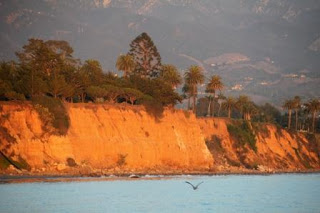 I am a sucker for that glow.
I am a sucker for that glow.